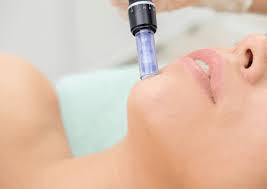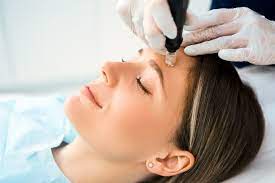Microneedling, also known as collagen induction therapy, is a revolutionary skincare treatment that has garnered significant attention in recent years for its ability to improve the appearance and texture of the skin. From treating acne scars to promoting anti-aging effects, microneedling offers a minimally invasive yet highly effective solution for a variety of skin concerns. But what exactly is the science behind microneedling, and why does it work so well? In this article, we will delve into the details of how microneedling works, its benefits, and the science behind its remarkable results.
1. What is Microneedling?
Microneedling Abu Dhabi is a cosmetic procedure that involves using a device equipped with fine needles to create tiny, controlled punctures in the skin’s surface. These tiny micro-injuries stimulate the body’s natural healing process, which triggers the production of collagen and elastin. Collagen and elastin are essential proteins that help maintain the skin’s strength, elasticity, and smoothness. By inducing this healing response, microneedling helps to rejuvenate the skin, improving its texture and appearance.
2. The Role of Collagen and Elastin in Skin Health
Before diving deeper into how microneedling works, it’s important to understand the role of collagen and elastin in maintaining youthful, healthy skin.
- Collagen is the most abundant protein in the skin and provides structure, firmness, and support. As we age, the production of collagen decreases, leading to the formation of wrinkles, fine lines, and sagging skin.
- Elastin allows the skin to stretch and bounce back, keeping it smooth and firm. Like collagen, elastin production also slows down with age, contributing to the loss of skin elasticity.
The goal of microneedling is to stimulate the production of these proteins to restore the skin’s youthful appearance and texture.

3. How Microneedling Works: The Process
Microneedling works by creating microscopic channels in the skin using fine needles. These controlled injuries stimulate the body’s natural healing response, leading to the following process:
- Injury Induction: The tiny needles puncture the skin’s outermost layer (the epidermis) and reach the dermis, the deeper layer of the skin that contains collagen and elastin fibers.
- Healing Response: In response to these micro-injuries, the body activates its wound-healing mechanisms. This leads to an increase in the production of collagen and elastin to repair the skin.
- Skin Regeneration: Over time, the increased collagen and elastin production helps to regenerate the skin, improving its texture, tone, and firmness. The process can take several weeks to months, but the results are often long-lasting.
The controlled nature of these micro-injuries ensures that the skin heals naturally and safely, without significant downtime or the risk of scarring.
4. Benefits of Microneedling
The science behind microneedling explains why it offers a wide range of skin benefits. Some of the most notable benefits include:
- Reduction of Fine Lines and Wrinkles: By stimulating collagen and elastin production, microneedling can help reduce the appearance of fine lines and wrinkles, giving the skin a smoother, more youthful appearance.
- Improved Skin Texture: Microneedling helps to improve skin texture by promoting the production of new, healthy skin cells. It can minimize rough patches, enlarged pores, and uneven skin tone.
- Scar Treatment: Microneedling is highly effective in treating acne scars, surgical scars, and stretch marks by promoting collagen regeneration in the affected areas.
- Hyperpigmentation and Sun Damage: Microneedling can also improve skin pigmentation issues, including hyperpigmentation, sun spots, and age spots, by stimulating the turnover of skin cells and encouraging a more even skin tone.
- Hair Regrowth: When used on the scalp, microneedling has been shown to stimulate hair growth, making it an effective treatment for individuals with thinning hair or early-stage hair loss.
5. The Science Behind Microneedling: How it Stimulates Collagen Production
Collagen production is essential for maintaining youthful, firm skin. Microneedling stimulates collagen production through a process called neocollagenesis, which is the body’s ability to form new collagen fibers.
When the skin is punctured by the microneedles, the small wounds created lead to inflammation, which triggers the release of growth factors and cytokines—molecules that are responsible for the healing process. This inflammatory response activates fibroblasts, the cells responsible for producing collagen and elastin. As a result, the skin begins to repair itself by producing new, healthy collagen and elastin fibers that fill in the gaps left by damaged tissue.
6. Microneedling Devices: Types and Technologies
Several types of microneedling devices are available, each designed to suit different skin needs and preferences. Some of the most common types of microneedling devices include:
- Dermarollers: These are handheld devices with a roller covered in tiny needles. The user rolls the dermaroller across the skin to create micro-injuries.
- Dermapens: These devices use a motorized pen with a cluster of fine needles that move up and down to create controlled micro-injuries.
- Automated Microneedling Pens: These pens use a motor to quickly insert the needles into the skin at adjustable depths, providing more precision and comfort than manual devices.
In addition to these traditional devices, there have been advancements in microneedling technology, including radiofrequency microneedling and microneedling with PRP (platelet-rich plasma), which further enhance the treatment’s results by incorporating additional rejuvenating properties.
7. Microneedling for Different Skin Types and Conditions
One of the reasons microneedling is so versatile is its ability to treat a wide range of skin types and conditions. The treatment is suitable for most individuals, including those with sensitive skin. However, some factors may determine the success of the procedure, such as:
- Skin Type: Microneedling is generally safe for all skin types, but individuals with darker skin tones may need to take extra precautions to avoid hyperpigmentation.
- Skin Conditions: Microneedling can treat acne scars, stretch marks, and even signs of aging. However, individuals with active acne or skin infections may need to wait until the skin is fully healed before undergoing treatment.
- Age: Microneedling is effective for individuals of all ages, but younger people with fewer skin concerns may benefit from it for prevention, while older individuals may use it to combat aging signs.
8. Microneedling vs. Other Skincare Treatments
When compared to other skincare treatments, microneedling stands out due to its non-invasive nature and its ability to address multiple skin concerns simultaneously. While treatments like chemical peels, laser therapies, and dermal fillers are effective in their own right, microneedling offers several advantages:
- Minimal Downtime: Microneedling typically involves little to no downtime, whereas laser treatments and chemical peels may require longer recovery periods.
- Natural Results: Unlike dermal fillers, which involve injecting foreign substances into the skin, microneedling stimulates the body’s natural healing process, resulting in natural and long-lasting improvements.
- Affordability: Microneedling is often more affordable than some other advanced skincare treatments, making it accessible to a wider range of individuals.
9. Potential Side Effects of Microneedling
While microneedling is generally safe, there are some potential side effects that patients should be aware of:
- Redness and Swelling: These are common post-treatment effects and typically subside within a few hours to a day.
- Bruising: Some individuals may experience minor bruising, especially if the needles penetrate deeper into the skin.
- Infection: Although rare, infections can occur if the microneedling process is not performed in a sterile environment or if aftercare instructions are not followed.
It’s essential to choose a trained and experienced professional to minimize risks and ensure optimal results.
10. Conclusion: Why Microneedling Is Here to Stay
The science behind microneedling is grounded in the body’s natural healing and regenerative processes, making it a powerful tool in the fight against aging, scarring, and other skin imperfections. Its ability to stimulate collagen and elastin production provides long-lasting results that are both safe and effective. Whether you’re dealing with acne scars, fine lines, or hair loss, microneedling offers a versatile solution with minimal downtime. As the demand for non-invasive cosmetic treatments continues to rise, microneedling is undoubtedly a technique that is here to stay in the world of skincare.
FAQs
- How many microneedling sessions are needed for visible results? Most people require between 3-6 sessions, spaced 4-6 weeks apart, to achieve optimal results.
- Does microneedling hurt? Microneedling can cause mild discomfort, but topical numbing cream is often applied before the procedure to minimize pain.
- How long does it take to recover from microneedling? Recovery time is typically quick, with redness and swelling subsiding within a day or two.
- Can microneedling treat deep wrinkles? Microneedling is effective for treating fine lines and moderate wrinkles, but more advanced treatments may be required for deeper wrinkles.
